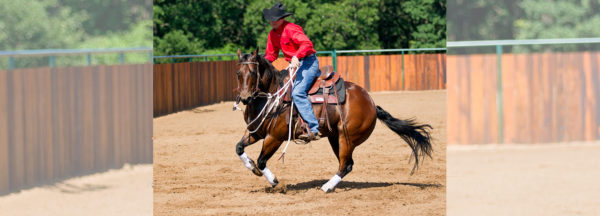Ask Clinton: Headset for Western Pleasure Horse

Q: I show my horse in western pleasure classes, but he doesn’t want to keep his head down anymore. He’s so energetic that he wants to look at everything. How can I convince him to keep his head down? – Pam D.
A: A horse that wants to look at everything going on outside or inside the arena is not concentrating on his rider. So rather than focusing on where your horse is keeping his head, work on getting him to pay attention to you. You’ll find that once he’s focused on you, he won’t be worried about what’s going on around him and will relax and listen to your cues again.
Horses have a reactive side and thinking side to their brains. The reactive side is what your horse is using – he’s energetic and not paying attention to you. Because of their high energy levels and lack of attention, horses using the reactive side of their brains can be dangerous. The thinking side is what we want our horses to use. When a horse uses the thinking side of his brain, he’s calm, attentive and safe. To get your horse to use the thinking side of his brain, you’ll move his feet forwards, backwards, left and right and always reward the slightest try.
I start each of my training sessions by doing groundwork with my horses – moving their feet forwards, backwards, left and right all around me. The more you can make your horse move his feet, the more respect he’ll have for you and the more he’ll use the thinking side of his brain. When you’re confident you have your horse’s attention and respect on the ground, get in the saddle.
Once in the saddle, don’t just ride your horse on the rail; keep his mind busy by working on transitions and softening and suppling his body (key components to collection) by practicing suppling exercises. Some of my favorite exercises are Bending at the Walk – asking the horse to bend his body in a circle around my inside leg at a walk and Bending Transitions – trotting or cantering the horse off and then picking up on one rein and asking him to bend in a circle around my inside leg at the walk. You can also practice Serpentines with your horse or trotting and cantering circles. The more you make his feet move and change directions, the more he has to focus on what you’re asking him to do rather than what’s going on outside the arena. When he’s got his attention on you, then you can practice riding on the rail, asking him to collect and carry his head level with his withers.
Also make sure your horse isn’t receiving too much grain. A lot of horses are overfed and underworked; meaning that they get too much grain for the amount of exercise they are given. If your horse is extremely energetic every day that you ride him, there’s a good chance he’s getting too much grain. If you adjust his feed accordingly and work on gaining his respect and attention, you’ll find he’ll relax and listen to you.
